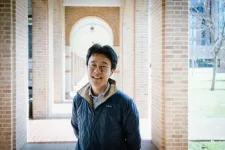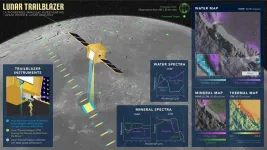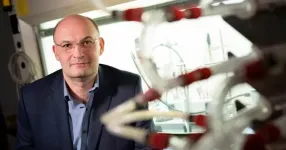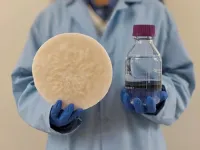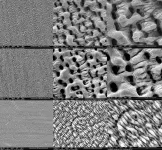Cold treatment does not appear to protect preterm infants from disability or death caused by oxygen loss, according to NIH-funded study
2025-02-25
(Press-News.org)
WHAT:
Lowering the body temperature of preterm infants (born at 33 to 35 weeks of pregnancy) with hypoxic ischemic encephalopathy (HIE)—a type of brain damage caused by oxygen loss—offers no benefits over standard care, according to a study funded by the National Institutes of Health (NIH). Previous studies of near-term and term infants (born after 36 weeks) with HIE found that this cooling treatment, which lowers body temperature to about 92 degrees Fahrenheit, significantly reduced the risk of death or disability by age 18 months (corrected for prematurity). However, the current findings show that such benefits are not observed for preterm infants with HIE. The authors noted that use of the cooling treatment in preterm infants has increased, despite little research on its effectiveness in this age group.
The study was conducted by Roger G. Faix, M.D., of the University of Utah, and colleagues at 19 newborn research centers. It appears in JAMA Pediatrics. Funding was provided by NIH’s Eunice Kennedy Shriver National Institute of Child Health and Human Development (NICHD).
HIE-associated oxygen loss can result from compression of the umbilical cord, a tear in the uterus, or other complications at birth. Of 188 preterm infants with HIE born from 2015 to 2020, 88 infants were assigned at random to the cooling treatment and 80 were maintained at normal temperature. Researchers evaluated occurrences such as death and moderate to severe disability when the infants were 18 to 22 months old. They found that 35% of those receiving the cooling treatment and 29% kept at normal temperature had died or had a disability. More specifically, deaths occurred in 20% of those receiving cooling treatment and 12% of those receiving standard care. Overall, preterm infants who received the cooling therapy had a 74% higher risk of death or disability and an 87% higher risk of death.
WHO:
Nahida Chaktoura, M.D., chief of the NICHD Pregnancy and Perinatology Branch, is available for comment.
ARTICLE:
Faix, RG et al. Whole-body hypothermia for neonatal encephalopathy in preterm infants 33-35 weeks gestation: a randomized clinical trial. JAMA Pediatrics DOI:10.1001/jamapediatrics.2024.6613 (2025)
###
About the Eunice Kennedy Shriver National Institute of Child Health and Human Development (NICHD): NICHD leads research and training to understand human development, improve reproductive health, enhance the lives of children and adolescents, and optimize abilities for all. For more information, visit https://www.nichd.nih.gov.
About the National Institutes of Health (NIH): NIH, the nation's medical research agency, includes 27 Institutes and Centers and is a component of the U.S. Department of Health and Human Services. NIH is the primary federal agency conducting and supporting basic, clinical, and translational medical research, and is investigating the causes, treatments, and cures for both common and rare diseases. For more information about NIH and its programs, visit https://www.nih.gov.
END
ELSE PRESS RELEASES FROM THIS DATE:
2025-02-25
BATON ROUGE – When faced with multiple food options and ultimately choosing one, the factors of that decision-making process may be more physiological than previously assumed. A group of scientists led by Pennington Biomedical Research Center’s Dr. Christopher Morrison recently discovered that the hormone fibroblast growth factor 21, or FGF21, plays an influential role in brain reward mechanisms like those involved in dietary choices.
The discovery was announced in the research team’s recent paper titled “FGF21 ...
2025-02-25
As electric vehicles (EVs) gain momentum in the fight against climate change, the conversation around public charging infrastructure is growing increasingly complex. Xinwu Qian , assistant professor of civil and environmental engineering at Rice University, is spearheading research that reimagines how and where charging stations should be deployed — ensuring that alignment with people’s daily routine and activities, beyond mere accessibility, are at the forefront.
“Charging an electric vehicle isn’t just about plugging it in and waiting — it takes 30 minutes to an hour even with the fastest charger ...
2025-02-25
On Wednesday 26 February, a thermal imaging camera built by researchers at the University of Oxford’s Department of Physics will blast off to the Moon as part of NASA’s Lunar Trailblazer mission. This aims to map sources of water on the Moon to shed light on the lunar water cycle and to guide future robotic and human missions.
Once in orbit, the spacecraft – weighing 200kg and about the size of a washing machine- will map the surface temperature and composition of the ...
2025-02-25
CHICAGO—February 24, 2025—Beacon Technology Solutions (Beacon), with collaborators at Illinois Institute of Technology (Illinois Tech), has been awarded a grant to support a novel study on how Far-UVC technology can help mitigate the spread of infectious diseases in public spaces. The grant was awarded through the Illinois Innovation Vouchers (IIV) Program, which fosters research collaborations between small- and medium-sized enterprises and Illinois’ world-class universities.
Beacon’s flagship product is a wall-mounted smart disinfection device that uses Far-UVC 222nm light, which has been shown to disinfect up to 99.99 percent ...
2025-02-25
New technology developed by researchers at the University of Houston could revolutionize medical imaging and lead to faster, more precise and more cost-effective alternatives to traditional diagnostic methods.
For years, doctors have relied on conventional 2D X-rays to diagnose common bone fractures, but small breaks or soft tissue damage like cancers often go undetected. More expensive and time-consuming MRI scans are not always suitable for these tasks in these detection or screening settings. Now, Mini Das, Moores professor at UH’s College of Natural Sciences and Mathematics and Cullen College ...
2025-02-25
WEST LAFAYETTE, Ind. — International process systems and operation experts have launched high-tech startup Crystallization Systems Technology Inc. (CrySyst) to streamline processes used by companies in the pharmaceutical and fine chemical industries.
CrySyst’s quality-by-control (QbC) framework addresses crystallization monitoring, modeling and control. The framework is based on research published in the April 15, 2020, and Oct. 5, 2021, issues of the journal Crystal Growth & Design and the Sept. 22, 2022, issue of the journal Industrial & Engineering ...
2025-02-25
Discarded food scraps, stray branches, seashells and many other natural materials are key ingredients in a new system that can pull drinkable water out of thin air developed by researchers from The University of Texas at Austin.
This new “molecularly functionalized biomass hydrogels” system can convert a wide range of natural products into sorbents, materials that absorb liquids. By combining these sorbents with mild heat, the researchers can harvest gallons of drinkable water out of the atmosphere, even in dry conditions.
“With ...
2025-02-25
COLUMBUS, Ohio – Researchers have developed a battery that can convert nuclear energy into electricity via light emission, a new study suggests.
Nuclear power plants, which generate about 20% of all electricity produced in the United States, produce almost no greenhouse gas emissions. However, these systems do create radioactive waste, which can be dangerous to human health and the environment. Safely disposing of this waste can be challenging.
Using a combination of scintillator crystals, high-density materials that emit light when they absorb radiation, and solar cells, the team, led by researchers from The Ohio State University, demonstrated that ambient ...
2025-02-25
A novel tool for rapidly identifying the genetic “fingerprints” of cancer cells may enable future surgeons to more accurately remove brain tumors while a patient is in the operating room, new research reveals. Many cancer types can be identified by certain mutations, changes in the instructions encoded in the DNA of the abnormal cells.
Led by a research team from NYU Langone Health, the new study describes the development of Ultra-Rapid droplet digital PCR, or UR-ddPCR, which the team found can measure the level of tumor cells in a tissue sample ...
2025-02-25
WASHINGTON, Feb. 25, 2025 – Keeping work surfaces clean during meat processing is a challenge. Bacteria from meat can attach, grow, and build up to create a biofilm that is difficult to remove, even on stainless steel surfaces used in industrial facilities. It can also aggregate, clumping together into an invisible mass that is stronger than individual cells, making it harder to kill using food-grade antibacterial surface cleaners.
In a paper published this week in Journal of Laser Applications, from AIP Publishing and the Laser Institute of America, researchers from the Hopkirk Research Institute, New Zealand Food Safety Science and Research Centre, ...
LAST 30 PRESS RELEASES:
[Press-News.org] Cold treatment does not appear to protect preterm infants from disability or death caused by oxygen loss, according to NIH-funded study
